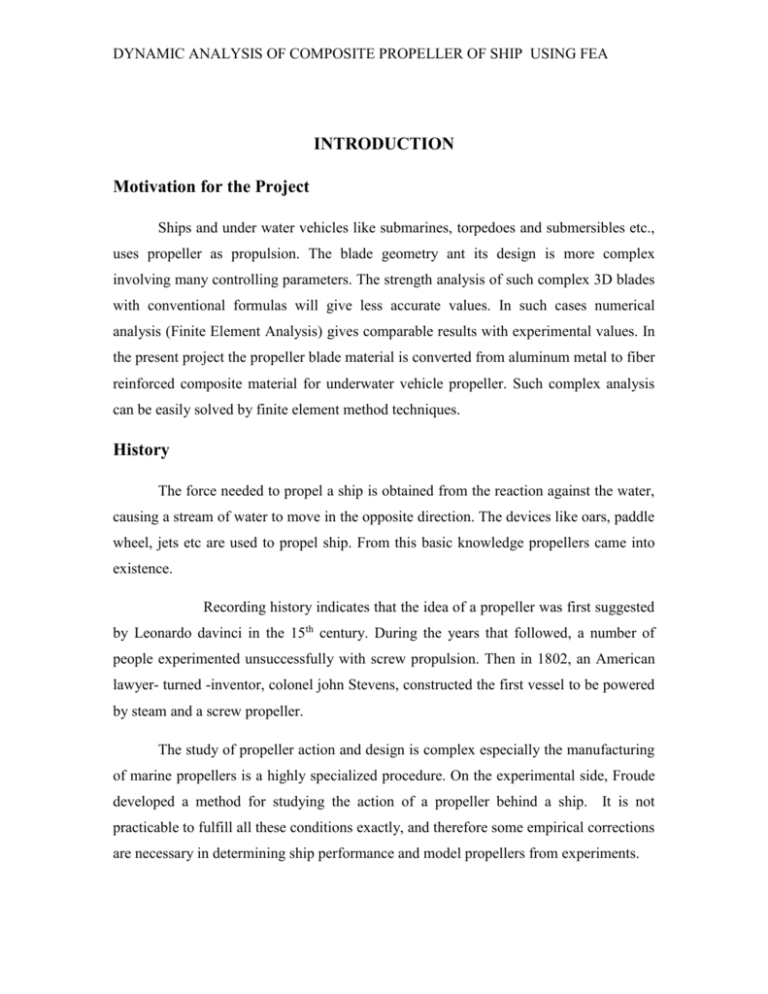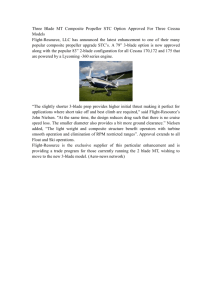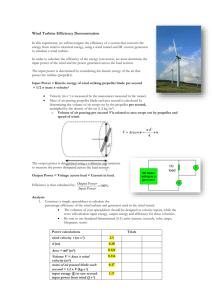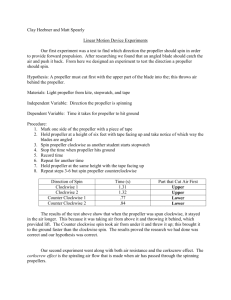Static analysis of aluminum propeller
advertisement

DYNAMIC ANALYSIS OF COMPOSITE PROPELLER OF SHIP USING FEA
INTRODUCTION
Motivation for the Project
Ships and under water vehicles like submarines, torpedoes and submersibles etc.,
uses propeller as propulsion. The blade geometry ant its design is more complex
involving many controlling parameters. The strength analysis of such complex 3D blades
with conventional formulas will give less accurate values. In such cases numerical
analysis (Finite Element Analysis) gives comparable results with experimental values. In
the present project the propeller blade material is converted from aluminum metal to fiber
reinforced composite material for underwater vehicle propeller. Such complex analysis
can be easily solved by finite element method techniques.
History
The force needed to propel a ship is obtained from the reaction against the water,
causing a stream of water to move in the opposite direction. The devices like oars, paddle
wheel, jets etc are used to propel ship. From this basic knowledge propellers came into
existence.
Recording history indicates that the idea of a propeller was first suggested
by Leonardo davinci in the 15th century. During the years that followed, a number of
people experimented unsuccessfully with screw propulsion. Then in 1802, an American
lawyer- turned -inventor, colonel john Stevens, constructed the first vessel to be powered
by steam and a screw propeller.
The study of propeller action and design is complex especially the manufacturing
of marine propellers is a highly specialized procedure. On the experimental side, Froude
developed a method for studying the action of a propeller behind a ship. It is not
practicable to fulfill all these conditions exactly, and therefore some empirical corrections
are necessary in determining ship performance and model propellers from experiments.
DYNAMIC ANALYSIS OF COMPOSITE PROPELLER OF SHIP USING FEA
Advantages and Disadvantages of Propeller:
Propellers will be used as a propulsors where the speed is slow and the propeller has to be
immersed completely in the water into a depth of minimum 2D. The efficiency of the
propeller will be reduced and noise will increase and start cavitation as the speed
increases. At high speeds the pump jet and water jet propellers will be used.
BASIC DEFINITIONS OF PROPELLER
1) Trailing edge
2) Face
3) Fillet area
4) Hub or Boss
5) Hub or Boss Cap
6) Leading edge
7) Back
8) Propeller shaft
9) Stern tube bearing
10) Stern tube
Propeller: The propeller is that component of the ship which converts the engine power
into the driving force of the ship.
Propeller Blades: Propeller blades are the projections radiating outwards from the centre
of the propeller.
DYNAMIC ANALYSIS OF COMPOSITE PROPELLER OF SHIP USING FEA
Modeling of propeller:
Modeling of the propeller is done using CATIA V5 R 19. In order to model the blade, it
is necessary to have sections of the propeller at various radii. These sections are drawn
and rotated through their respective pitch angles. Then all rotated sections are projected
onto right circular cylinders of respective radii as shown in figure below. Now by using
multi section surface option, the blade is modeled.
Fig 4.5 construction of hydrofoils by joining of points on surface of the blade
Fig 4.6 final solid model of propeller
MESH GENARATION USING HYPERMESH:
The solid model is imported to HYPERMESH 10.0 and tetrahedron mesh is
generated for the same. Boundary conditions are applied to meshed model. The contact
surface between hub and shaft is fixed in all degrees of freedom. Thrust of 4000 N is
uniformly distributed in the region between the sections at 0.7R and 0.75R on face side of
DYNAMIC ANALYSIS OF COMPOSITE PROPELLER OF SHIP USING FEA
blade, since it is the maximum loading condition region on each blade. The loading
condition is as shown in fig 4.7.Nummber of nodes created were and number of elements
created are 1,65,238.
Power=50 Kw velocity=12.5 m/s
Thrust = power/velocity
=50000/12.5
=4000 N
Fig 4.7 : loading on meshed model.
The various steps in Finite Element Analysis are as described below:
• Step 1: Discretization of the structure
Divide the structure or continuum or solution region into finite elements i.e. the structure
is to modeled using finite elements. The number , type. size and affangement
of the elements are to be decided. Mesh generation programs called “Preprocessors” can
be used for this purpose.
• Step 2: Formulate the properties of each element This means determining nodal loads
associated with all element deformation are allowed.
states that
• Step 3: Selection of proper interpolation or displacement model
The displacement solution of a complex structure under any specified load condition can
not be predicted exactly. We assume suitable solution with an element to approximate the
DYNAMIC ANALYSIS OF COMPOSITE PROPELLER OF SHIP USING FEA
unknown solution. The assumed solution must be simple from computational point of
view, but it should satisfy certain convergence and compatibility requirements. Generally
the solution or interpolation model is in the form of a polynomial.
• Step 4: Derivation of element stiffness matrix and load vector
From the assumed displacement model the stiffness matrix [ke] and load
vector{F1} of an element “e” are to be derived by using either equilibrium conditions or
a suitable variational principle.
• Step 5: Assemblage of element equations
As a structure is composed of several finite elements. the individual element stiffness
matrices and load vectors are to be assembled in a suitable manner and the overall
equilibrium equations have to be formulated as KQ=F, where
K is global or structural stiffness matrix
Q is vector of nodal displacements
F is vector of nodal forces for complete structure.
• Step 6: Solution for unknown nodal displacements
The equilibrium equations have to be modified using the boundary conditions of the
problem. After incorporating the boundary conditions the equilibrium equations are
expressed as KQ=F. For linear problems the displacement vector Q can be solved very
easily, but for non linear problems. the solution is obtained by solving a sequence of
steps, each step involving the modification of stiffness matrix K or load vector F.
• Step7: Computation of element stresses and strains
From the known displacement Q the stresses and strains are computed using necessary of
solid and structural mechanics.
• Step 8: Presentation of results
Using output interpolation programs called ‘Postprocessors” the results can be framed
and displayed in vector or raster forms as desired.
DYNAMIC ANALYSIS OF COMPOSITE PROPELLER OF SHIP USING FEA
RESULTS AND DISSCUSSIONS
LINEAR STATIC ANALYSIS :
Linear static analysis is concerned with the behavior of elastic continua under prescribed
boundary conditions and statically applied loads. The applied load in this case is thrust
acting on blades. Under water vehicle with contra rotating (aft) propeller is chosen for FE
analysis. The FE analysis is carried out using ANSYS. The deformations and stresses are
calculated for aluminum (isotropic) and composite propeller (orthotropic material). In
composite propeller 4 cases are considered, those are number of layers is varied as 4 and
8. For propeller blade analysis 3D solid element type 92 is considered for aluminum and
solid 46 for composite propeller.
Static analysis of aluminum propeller:
The thrust of 4000N is applied on face side of the blade in the region between 0.7R and
0.75R. The intersection of hub and shaft point’s deformations in all directions are fixed.
The thrust is produced because of the pressure difference between the face and back sides
of propeller blades. This pressure difference also causes rolling movement of the under
water vehicle. This rolling movement is nullified by the forward propeller which rotates
in other direction (reverse direction of aft propeller). The propeller blade is considered as
cantilever beam i.e. fixed at one end and free at other end. The deformation pattern for
aluminum propeller is shown in figure 6.1. The maximum deflection was found as
4.402 mm in y-direction. Similar to the cantilever beam the deflection is maximum at free
end.
The maximum von mises stress induced for aluminum blade is 525.918 N/mm2 as
shown in figure 6.2.The stresses are greatest near to the mid chord of the blade-hub
intersection with smaller stress magnitude toward the tip and edges of the blade.
DYNAMIC ANALYSIS OF COMPOSITE PROPELLER OF SHIP USING FEA
Static analysis of propeller
Static deflection of aluminum propeller
Max normal stresses of aluminum propeller Von-mises stress of aluminum propell
Static deflection of composite propeller with 4 layers
DYNAMIC ANALYSIS OF COMPOSITE PROPELLER OF SHIP USING FEA
HARMONIC ANALYSIS OF ALUMINUM PROPELLER:
Amp-freq graph of aluminum propeller in Uy direction
Amp-freq graph of aluminum propeller in Ux direction
Amp-freq graph of aluminum propeller in Uz direction
DYNAMIC ANALYSIS OF COMPOSITE PROPELLER OF SHIP USING FEA
HARMONIC ANALYSIS OF COMPISTE PROPELLER
Case 1: 4 layers
Amp-freq graph of 4 layer composite propeller in Ux direction
Amp-freq graph of 4 layer composite propeller in Uy direction
Amp-freq graph of 4 layer composite propeller in Uz direction
DYNAMIC ANALYSIS OF COMPOSITE PROPELLER OF SHIP USING FEA
Amp-freq graph of 4 layer composite propeller nearer to away from hub in Ux direction
Amp-freq graph of 4 layer composite propeller nearer to away from hub in Uy direction
Amp-freq graph of 4 layer composite propeller nearer to away from hub in Uz direction
DYNAMIC ANALYSIS OF COMPOSITE PROPELLER OF SHIP USING FEA
CONCLUSIONS
The following conclusions are drawn from the present work:
1. The deflection for composite propeller blade was found to be around 0.5mm for all
layers which is much less than that of aluminum propeller i.e. 6.883mm, which shows
composite materials is much stiffer than aluminum propeller..
2. Inter laminar shear stresses were calculated for composite propeller by incorporating
different number of layers viz. 4 and 8 was found that the percentage variation was about
3.147%,which shows that there is strong bonding between the layers and there’s no peeloff.
3. Modal analysis results showed that the natural frequencies of composite propeller were
80.5% more than aluminum propeller, which indicates that the operation range of
frequency is higher for composite propeller.
Future scope of work:
1. The present work only consists of static and Modal analysis, which can be
extended for transient and spectrum analysis in case of both aluminum and
composite materials.
2. There is also a scope of future work to be carried out for different types of
materials, which can be extended for CFD analysis.
DYNAMIC ANALYSIS OF COMPOSITE PROPELLER OF SHIP USING FEA
REFRENCES
1. Taylor, D.w, “The Speed and Power and Ships”, Washington, 1933
2. J.E.Conolly, “Strength Of Propellers”, reads in London at a meeting of the royal
intuition of naval architects on dec 1.1960,pp 139-160
3. Terje sonntvedt, “Propeller Blade Stresses, Application Of Finite Element
Methods” computers and structures, vol.4,pp193-204
4. Chang-sup lee, yong-jik kim,gun-do kim and in-sik nho. “Case Study On The
Structural Failure Of Marine Propeller Blades”
5. M.Jourdain, visitor and J.L.Armand. “Strength Of Propeller Blades-A Numerical
Approach”, the society of naval architects and marine engineers, may 2425,1978,pp 20-1-21-3.
6. G.H.M.Beek, visitor, lips B.V.,Drunen. “Hub-Blade Interaction In Propeller
Strength”, the society of naval architects and marine engineers, may 2425,1978,pp19-1-19-14
7. George W.Stickle and John L Crigler. “Propeller analysis from experimental data”
report No.712, pp 147-164.
8. P.Castellini, C.Santolini. “Vibration Measurements On Blades Of A Naval
Propeller Rotating In Water With Tracking Laser Vibromneter ”Dept. of
mechanics, university of Ancona, pp43-54
9. W.J.Colclough and J.G.Russel. “The Development Of A Composite Propeller
Blade With A CFRP Spar” aeronautical journal, Jan 1972, pp53-57
10. J.G.Russel “use of reinforced plastics in a composite propeller blade” plastics and
polymers, Dec 1973 pp292-296
11. Christoph Layens, Frank Kocian , Joachim hausmann. “Materials And Design
Concepts For High Performance Compressor Components”
12. Ching-Chieh Lin, Ya-jung Lee. “Stacking Sequence Optimization Of Laminated
Composite Structures Using Genetic Algorithm With Local Improvement”.
Composite structures 63(2004), pp339-345






